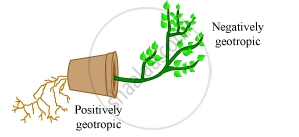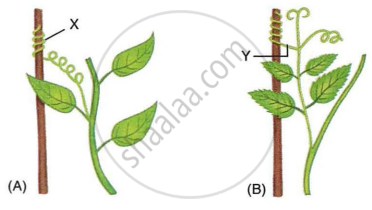Advertisements
Advertisements
Question
What is meant by ‘positive geotropism’ and ‘negative geotropism’? Give one example of each type. Draw a labelled diagram to illustrate your answer, indicating the plant part, which shows positive geotropism, and the plant part, which shows negative geotropism.
Solution
If the movement of the plant parts is towards the pull of gravity, it is known as positive geotropism; whereas if the movement of the plant parts is in the direction opposite to the pull of gravity, it is known as negative geotropism.
The movement of roots towards the soil is an example of positive geotropism, whereas the movement of plant stems away from the soil in the upward direction is an example of negative geotropism.

RELATED QUESTIONS
How do auxins promote the growth of a tendril around a support?
Name one example of the movement of a plant part which is very quick and can be observed easily.
What does a Mimosa pudica plant do in response to touch? What is this phenomenon known as?
What happens to the moonflower
- during the daytime, and
- at night?
What is this phenomenon known as?
Distinguish between tropic movements and nastic movements in plants. Give examples to illustrate your answer.
Name the plant part which bends towards light but away from the force of gravity.
The plant part which exhibits negative geotropism is :
(a) root
(b) stem
(c) branch
(d) leaves
The root of a plant is :
(i) positively phototropic but negatively geotropic
(ii) positively geotropic but negatively phototropic
(iii) negatively phototropic but positively hydrotropic
(iv) negatively hydrotropic but positively phototropic
(a) (i) and (ii) (b) (ii) and (iii) (c) (iii) and (iv) (d) (i) and (
P and Q are two types of plants having weak stems which cannot stand upright on their own. The plants P and Q have organs R and S respectively which can grow towards any support which they happen to touch and wind around that support. It is observed that organ R originates from the leaves of the plant whereas organ S originates directly from the stem of the plant.
(a) What is (i) R, and (ii) S?
(b) What is the name of growth movement exhibited by the organs R and S?
(c) Name the stimulus involved in this case.
(d) State whether the behaviour of organs R and S is a tropic movement or a nastic movement.
(e) Name one plant like P and another plant like Q.
Study the diagrams given below and answer the following questions:

- Name the structures shown as X and Y in the figures (A) and (B), respectively.
- Write the functions performed by the structures X and Y.
- Name the phenomenon depicted and define it.
- How do the structures X and Y differ from each other?
- Give examples of the plants which show the said phenomenon.
